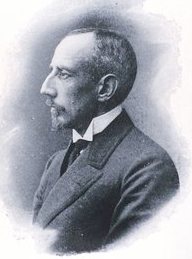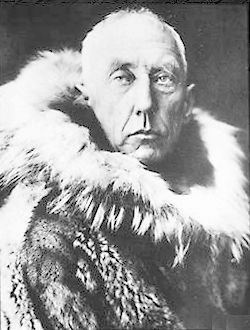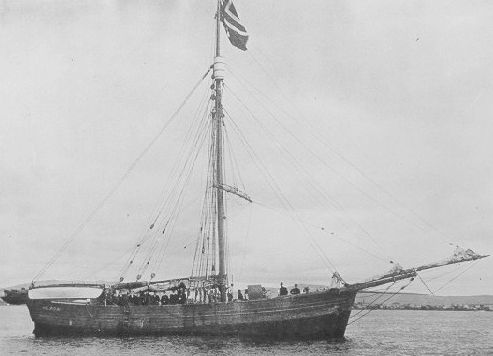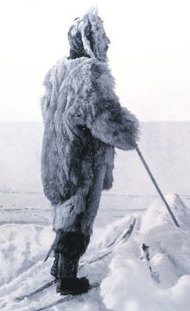|
Roald
Amundsen (July 16, 1872-June 22, 1928) was a Norwegian
polar explorer who was the first person to fly over the
North Pole in a dirigible (May 11-13, 1926) and was the
first person to reach the South Pole. He was the first
person to reach both the North and South Poles.
Amundsen
and his small expedition reached the South Pole on
December 14, 1911, traveling by dog sled. Amundsen was
also the first person to sail around the world through
the Northeast and Northwest passages, from the Atlantic
to the Pacific (in 1905).

Roald
Amundsen
EARLY
LIFE
Amundsen was born on July 16, 1872, near Oslo, Norway.
As a teenager, he had been fascinated by the adventures
of the explorer John Franklin, and wanted to be an
explorer himself. His mother, however, wanted him to be
a doctor (his father died when Roald was 14). When Roald
was 21, his mother died, and he stopped studying
medicine and began preparating for a trip to the Arctic.
FIRST
WANDERINGS
On his early trips, Amundsen was a deckhand. By 1897, he
was first mate (on the Belgica) on a Belgian expedition
to the Arctic; it was the first expedition to overwinter
at the Arctic (the ship had been caught in the ice, so
they were forced to stay until the ice melted). On this
trip, scurvy (a lack of vitamin C) began to make the
crew ill, but Amundsen saved them by making them eat
seal meat (which is high in vitamin C).
MAGNETIC
NORTH POLE
In 1899, Amundsen became a sea captain himself and
organized an expedition to go to the North Magnetic
Pole. In 1900, he bought a ship called the Gjoa. On June
16, 1903, with a crew of 6, Amundsen sailed from Oslo,
Norway, around the south of Greenland, through Baffin
Bay, and on to King William Island (in northern Canada),
where they spent two years building two ships, an
astronomical observatory, and a couple of huts. While on
the island, the Netsilik Indians taught them Arctic
survival techniques. During this time, they also mapped
that frozen, island-studded area.

Roald
Amundsen in furs
In
1904, Amundsen and his small crew continued on to the
North Magnetic Pole, which had moved 30 miles since it
was originally located by James Clark Ross in 1831. This
was the first time that anyone had realized that the
magnetic poles do indeed move. In 1905, they sailed
through (and named ) Queen Maud Gulf (named for the
Queen of Norway). They continued northwest until they
were trapped in ice near Herschel Island. Amundsen
traveled by dogsled to Eagle, Alaska (by the Yukon
River), where he telegraphed word of his successful
navigation of the Northwest Passage (a water route from
the Atlantic Ocean to the Pacific Ocean across the
northern part of North America). The ship reached Nome,
Alaska, in September, 1906. Amundsen was treated as a
hero. On the historic trip, only one crew member had
died (of a ruptured appendix).
THE
SOUTH POLE
In 1910, Amundsen sailed for Antarctica, intending to be
the first person to make it to the South Pole (although
he had originally planned to go to the North Pole, Peary
and Henson had surprised him by making it to the North
Pole, so Amundsen had sudden changed his plans).
Amundsen set up a base camp at the Bay of Wales (by the
Ross Ice Shelf). On December 14, 1911, Amundsen and his
crew made it to the South Pole on dog sleds. They
returned to their base camp on January 25, 1912; they
had covered 1,860 miles in 99 days. The British explorer
Robert
Falcon Scott had also tried to be the first to the
South Pole, but Amundsen beat him there (and Scott and
his crew all died on the return trip).

Roald
Amundsen's ship - Alaska
From 1918 until 1921, Amundsen tried unsuccessfully to
use Arctic currents to drift to the North Pole. In the
process, however, he sailed through the Northeast
Passage (the sea passage from northern Europe across
northern Asia to Alaska); he was only the second person
in history to do this (A. E. Nordenskjold was the
first).
Amundsen
then decided to fly to the North Pole. With financing
from the millionaire explorer Lincoln Ellsworth, they
had many unsuccessful tries. Richard Evelyn Byrd
eventually reached the North Pole by plane in May, 1926.
When Byrd returned Spitsbergen, Norway, Amundsen and
Byrd met. Two days later, May 11, 1926, Amundsen left
for the North Pole in a dirigible (blimp) designed and
flown by the Italian explorer, pilot and engineer
Umberto Nobile. Amundsen and Nobile reached the North
Pole on May 11. Although they had some weather and
mechanical troubles, they eventually returned to Point
Barrow, Alaska, on May 14.
PLANE
CRASH
Amundsen
died in a plane crash in the summer of 1928, while
attempting to rescue his friend Nobile, who had been
lost in a dirigible crash in the Arctic (Nobile was
found by another search crew). Amundsen disappeared on
June 18, 1928, with his French flight crew; Amundsen's
body was never found. Amundsen was 55 years old when he
died.

Roald
Amundsen at the South Pole
LINKS:
This
page may contain links to educational sites around the
world under the headings provided. Content on
those sites may be the subject of author copyright,
which is hereby acknowledged.
|